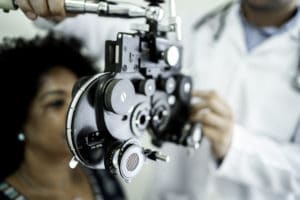What Is Enucleation?
Enucleation is a surgical procedure that involves the removal of the entire eye, it will preserve the periorbital and orbital structure. In most cases, an implant will be placed to replace the eye. A prosthetic or “glass eye” can be made after surgery to match the other eye.

When Is Enucleation Needed?
There are a number of reasons for an enucleation to be performed:
- Trauma
- Blind painful eye
- Malignancy
Enucleation is necessary in cases of severe eye injury, eye cancer, uncontrollable infection, and other serious diseases of the eye. It is a last resort, only used with it is impossible to save the eye. Enucleation is most typical with eye cancer, and this is the only way to be able to remove the tumor from the body to keep it from spreading to other areas. When a large tumor has invaded the eye, the patient already has little to no vision in the eye. Enucleation may also be necessary in patients with severe glaucoma. If a patient has lost vision in an eye, enucleation is performed to remove the blind eye and to rehabilitate the eye socket. This enables the patient to have a prosthetic replacement that is a far better cosmetic option.
Symptoms Of Enucleation
- A blind eye that is painful
- Malignancy
- Trauma
What Are The Signs A Person Could Need Enucleation?
Other than in cases of injury, these are not immediate situations. Generally, the patient will have been losing more and more of his or her sight as the tumor has grown within the eye. The most common eye cancer comes from melanoma, skin cancer. Uncontrollable infections can also invade the eyes. If the patient has had long-term glaucoma, vision loss has been increasing.
Also, when a person has lost vision in an eye, cosmetically replacing it with a prosthetic enables the person to feel less self-conscious about the eye.
How Is Enucleation Performed?
These surgeries are performed with the patient under general anesthesia. The entire eye is removed. The muscles that were attached to the outside of the eyeball to control its movement and other tissues that surrounded the eye within the bony socket of the skull are left intact. A prosthetic replacement cannot be fitted at this time, as swelling has to subside and healing needs to take place.
In most cases, Dr. Keverline places a small plastic conformer that resembles half an almond shell behind the eyelids to maintain their shape after enucleation surgery. The conformer serves as a placeholder for the artificial eye that will be fitted in several weeks. An implant typically made of porous material is placed in the space of the inner eye. A single stitch may be placed in the eyelids to temporarily sew them together for a few days.
What Are The Risks Of Surgery?

Complications of this surgery include hemorrhage, infection, and extrusion of the implant. Hemorrhage is rare and is more typical with patients who are on blood thinners such as Coumadin or have a bleeding disorder. Secondary infections are also rare, but they can be managed with antibiotics or sometimes surgical removal and replacement of the prosthetic implant. Extrusions can be managed with replacement surgery, as well.
What Is Recovery Like After Enucleation?
It’s common for patients to have a headache for one to two days after enucleation. Some patients can also be nauseous for the same period of time. Immediately after surgery, we will apply a pressure patch. In most cases, we’ll want this to stay on for a few days. The eye is surrounded by bone, so the pain of this removal isn’t as strong as most patients anticipate. Patients are given oral antibiotics and steroids to take until their follow-up appointment 4-6 days after surgery. At that point, we’ll remove your pressure patch, examine the surgical wound, and give you topical antibiotic drops or ointment to apply to the area several times a day for a couple of weeks. We usually place a temporary prosthesis at this time.
Approximately 3-6 weeks after your enucleation surgery, when Dr. Keverline feels you’re ready, you will be referred to an ocularist. An ocularist is a professional who specializes in the custom crafting of artificial eyes.
How Do I Adjust To My New Vision After Enucleation?
You will have a difficult adjustment period, although this can depend upon how much vision you may have lost in your eye prior to the need to remove it. You will have a loss of depth perception and a significant portion of your field of vision. This may affect your ability to drive a car, or your license may be subject to some restrictions.
Some degree of depression, particular about your perceived appearance (even though most people cannot tell you have an artificial eye), is common. Support groups can really help.
It’s not rare for patients who have undergone enucleation to experience hallucinations, phantom pains, and headaches. Approximately one quarter of patients experience phantom pain in the removed eye. Others report painless, but disturbing phantom sensations.
When Can I Return To Work And Activities After Enucleation?
Patients can return to normal activity sooner than they usually expect. The orbit heals quickly, and patients can return to work or school within just 2 to 6 weeks. It’s important for the first two weeks to not lift more than 10 pounds, strain, or rub your eye. You’ll also need to avoid blood thinners such as aspirin.
Can I Wear Contact Lenses After Enucleation?
While it is possible to wear a contact lens on your remaining natural eye, we do not recommend this. We advise all enucleation patients purchase eyeglasses with impact-resistant polycarbonate lenses and wear these glasses at all times to protect their remaining eye.
It’s not worth the risk of developing even a minor eye injury, such as a corneal abrasion or risking the possibility of an eye infection in your natural eye, both of which can occur when wearing contact lenses.
What Are My Options For My Prosthetic Eye?
Patients often assume artificial eyes are still made of glass, as they were for a long period of time. Today, a thin, curved, glossy painted acrylic disc is made to look exactly like your other natural eye. It has an iris, pupil, white, and even blood vessels. The disc is placed in front of a porous round implant that is inserted into the eye socket and covered with eye tissue called conjunctiva. The disc can be removed, cleaned, and replaced when needed.
Patients having enucleation can opt to have a stock prosthetic, but we recommend using an ocularist to make a custom prosthesis because it typically will provide a better fit and match your natural eye much more precisely.
For your fitting, the ocularist uses a foam material to take an impression of your eye socket to create your prosthetic eye. From there, the fit will be adjusted until you’re fully comfortable.
Schedule a Consultation
Southside Eye Care proudly serves Chesapeake, Norfolk, Portsmouth, Suffolk and Virginia Beach Virginia as well as the surrounding areas. For more information on Eyelid Reconstruction call us at 757-484-0101 today or fill out our contact form for more information.

